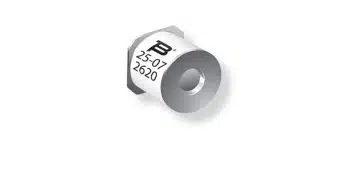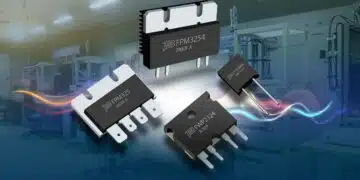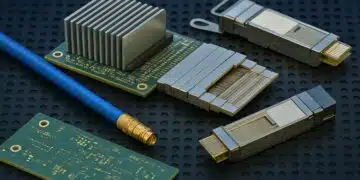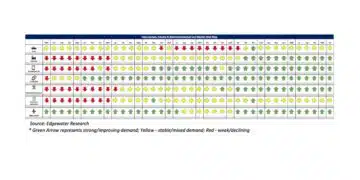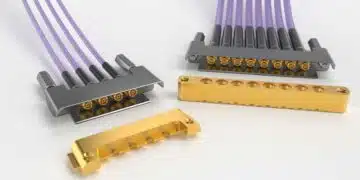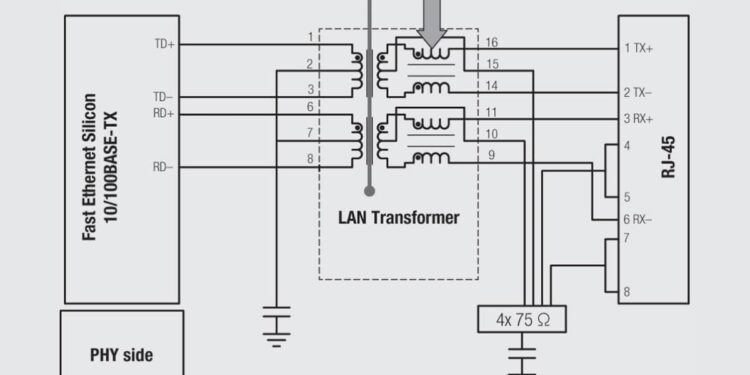As noted, the current rating of a contact is determined by the T-rise as a function of current. The T-rise is dependent on the balance of the Joule heating, given by I2R, and the heat dissipation, primarily through thermal conduction to the wire or PWB to which the connector is terminated. Consider first the heat generation side of the equation.
The components of contact/connector resistance were discussed in Chapter I/1.3.3 The Electrical Interface: Contact Resistance. For the purposes of this discussion it is sufficient to note the dependence of the resistance of all these components on the resistivity and geometry of the permanent connections, the contacts (plug and receptacle) and the contact interface. So the reduction of heat generation will be facilitated by reducing the resistivity (increasing the conductivity) of the contact spring materials, increasing the conductor cross sections and reducing the contact lengths. It should be noted that there are two additional ways to reduce the contact interface resistance, by increasing the contact normal force and by using multiple contact beams to take advantage of the parallel resistances and redundancy.
On the heat dissipation side of the equation these same design/material changes will enhance the heat dissipation. In metals the electrical and thermal conductivities correlate with one another. The geometric effects are straightforward with respect to thermal conductivity. But there is a second effect to be considered, the heat sinking capacity. For example, the heat sinking capacity of a 1 mm2 conductor, or a 1 ounce copper power/ground plane, is less than that of a 4 mm2 conductor, or a 2 ounce copper power/ground plane in a PWB.
These comments explain why high current capacity contacts tend to be made from high conductivity materials, have high contact forces, use multiple contact beams and are large in cross section.
There are two aspects to the current rating process. The first is the philosophy of current rating, how the samples are prepared and conditioned. The second is the practice of measuring T-rise. Standards exist that define the test procedures for measuring T-rise. The philosophy of current rating, however, is not well defined. Some of the key philosophical decisions include:
• Out Of the Box, OOB (no conditioning) or conditioned
• Conditioning options include “representative or End-of-Life (EOL)
• Free Air or In housing
• T-rise criterion
Consider the implications of each of these decisions.
OOB vs. conditioned
An OOB rating process is essentially a design verification process. It demonstrates that the design/materials options used in the connector are capable of meeting the specification requirements. However, such a program provides no indication of the stability of the design in the field.
Conditioning options
An example of “representative” conditioning relevant to connector durability would be to mate and unmate the connector 200 times (taken as representative of a “typical” application) for a connector specified for 500 mating cycles. EOL conditioning for this example would be 500 mating cycles.
The other conditioning options include which exposures to include in the program and the number of cycles or exposure durations. Common exposures include mating/unmating, corrosion, stress-relaxation (heat age or Temperature life) and a mechanical exposure such as vibration or shock. Representative and EOL exposures can be developed or defined for these options.
Free Air vs In Housing
A free air sample would provide the highest current rating because it would allow for the maximum heat dissipation. An in-housing sample would, of course, be representative of the application and is, therefore, preferred.
T-rise Criterion
As noted a 30 degree T-rise over ambient is the most commonly used criterion based on a number of Standards. That number, however, is arbitrary and other criteria may be applied.
The most important conclusion to be drawn from this discussion is that a comparative evaluation of contact/connector rating practices must ensure that the test program is identical with respect to all of these options for the comparison to be definitive. The two major issues are EOL vs representative conditioning and the T-rise criteria.



